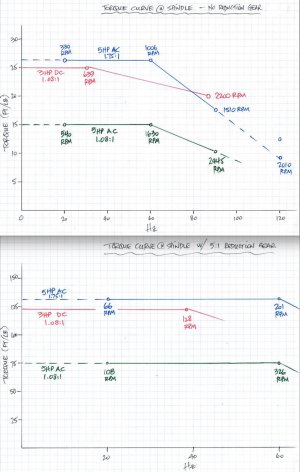It is good to figure out the torque and Hp vs. spindle speed and factor in the effects of the reduction gear, but I would also look at other VFD factory lathes and and also those that have retrofitted similar lathes. In addition modern VFD's can apply higher torque levels for different periods of time, but they are very hard to stall out. In almost all cases, a you will find that a 5Hp motor with a 2 speed gearbox (typically with reduction ratios of 5-8:1) are the norm. They are pretty much unstoppable under any load they would face in a hobbyist setting. In fact even a 3 Hp vector motor would run well. The main focus in my experience has been to optimize the performance range of the motor to the desired spindle speeds. In the case of using a non-inverter motor, typically you will max out the RPM at around 90-100 Hz, more so because of performance drop off beyond this range. On the low end, typically 15-20 Hz based on torque falling off below that range and cooling issues in a TEFC motor which are typical cooling method for these types a motor. You can go to 120 Hz, but Hp will start to drop off and torque can be significantly reduced, that being said you typically do not need high levels of torque at speed. So your pulley ratio is set more by the top speed of your motor, and the reduction ratio is fixed.
An Inverter/vector motor will spin up to 5-6K and so the whole power scale is shifted (and much wider) and also has a higher motor to spindle belting ratio. If you take a standard motor, run it to 100 Hz you would use 1:1.2 drive ratio to the spindle so multiple the Hp and torque of the motor speed x 1.2 to get the applied spindle forces. At 60 Hz the spindle speed will be ~1450 RPM. Take an inverter vector motor to 200 Hz, your spindle to motor RPM ratio is now 1:2.4, at 60 Hz the spindle speed will be ~1050 RPM, but with 2.4x the mechanical ratio, and even at 30 Hz (525 RPM) you still will have significant higher torque and Hp because of the higher motor pulley ratio. I can tell you from numerous installs that you could take a 5 Hp inverter/vector motor down to 10 Hz and I still doubt you could stall it. In either case, a vector motor operating range would be around 20-200 Hz, so in high gear you have a spindle speed of around 250-2500, and in low gear you I wouldn't run the gearbox input past what it was designed for ~3000 RPM (100 Hz) input with a 5:1 reduction would be 600 RPM and then you have a belt reduction of 2.4 which would put you at 250 and around 35 RPM at 15 Hz but with twice the applied mechanical ratio of the non-inverter vector motor at the same Hz. So a pretty significant increase in performance, but bottom line neither motor will be stoppable. Last but not least there can be issues of motor pulsations, one area where the DC motors a very smooth. Really not an issue with 3 phase motors v.s. single phase, and an inverter/vector motor should be smoother than a standard motor at the same spindle speed (i.e. the inverter/vector motor will be spinning faster for the same spindle speed).
So with either motor you need to look at the operating range and mechanical ratio to optimize the operating range/performance of the motor. My lathe model comes in a 1340/1440 and has either a 3 Hp (8 speed) or 5 Hp (2 speed) with factory VFD. I went with a 3 Hp (inverter rated, not a vector), which I operate from ~15-80 Hz, I can take heavy DOC cuts even at the low speed and it is unstoppable. I primarily use just the high low gear only which is 1500/300 RPM. I did purchase a Lincoln inverter vector motor for it, but never found the need to go that route.



